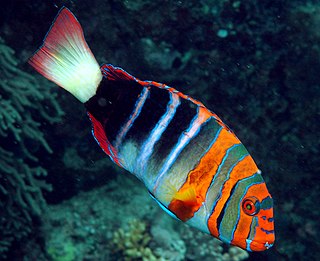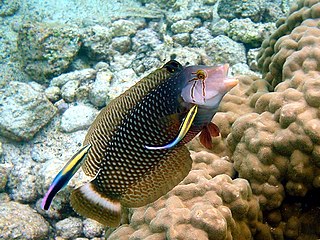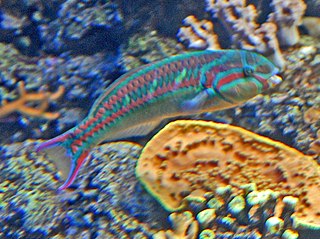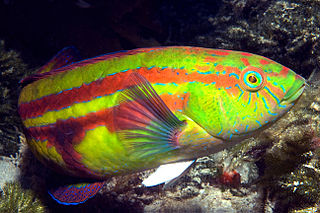
The wrasses are a family, Labridae, of marine ray-finned fish, many of which are brightly colored. The family is large and diverse, with over 600 species in 81 genera, which are divided into nine subgroups or tribes.

Achoerodus is a genus of wrasses collectively known as blue gropers. They are found in the coastal waters of southern Australia and distinguished by the bright blue colouring of the adult males.

Bodianus or the hogfishes is a genus of fish in the family Labridae found in the Atlantic, Indian and Pacific Ocean. These species have many parasites.

Choerodon is a genus of wrasses native to the Indian Ocean and the western Pacific Ocean. They are commonly referred to as tuskfish, because most species have sharp tusk-like teeth.

Cleaner fish are fish that show a specialist feeding strategy by providing a service to other species, referred to as clients, by removing dead skin, ectoparasites, and infected tissue from the surface or gill chambers. This example of cleaning symbiosis represents mutualism and cooperation behaviour, an ecological interaction that benefits both parties involved. However, the cleaner fish may consume mucus or tissue, thus creating a form of parasitism called cheating. The client animals are typically fish of a different species, but can also be aquatic reptiles, mammals, or octopuses. A wide variety of fish including wrasse, cichlids, catfish, pipefish, lumpsuckers, and gobies display cleaning behaviors across the globe in fresh, brackish, and marine waters but specifically concentrated in the tropics due to high parasite density. Similar behaviour is found in other groups of animals, such as cleaner shrimps.

Semicossyphus, commonly known as sheephead wrasses, are an invalid genus of wrasses native to the Pacific Ocean. It is now considered a synonym of Bodianus.

Novaculichthys taeniourus, also known as the rockmover wrasse, carpet wrasse, dragon wrasse, bar-cheeked wrasse, olive-scribbled wrasse or reindeer wrasse, is a species of wrasse mainly found in coral reefs and lagoons in the Indo-Pacific region. These include habitats in the Gulf of California to Panama; tropical Pacific Ocean islands including Hawaii; the Philippines, Indonesia and Australia; and the Indian Ocean to the east coast of Africa. The common name, "rockmover wrasse", comes from their behavior of upending small stones and reef fragments in search of prey. This species is the only known member of its genus.

The fivestripe wrasse, also known as the red-ribbon wrasse, is a species of marine ray-finned fish, a wrasse, from the family Labridae. It is found in the Indo-Pacific region.

The slingjaw wrasse is a species of wrasse from the family Labridae which is native to the tropical waters of the Indo-Pacific where it occurs around coral reefs. This species is of minor importance to local commercial fisheries and can be found in the aquarium trade. Relatively mundane at first glance, this fish is notable for its highly protrusible jaws.

The inscribed wrasse is a species of marine ray-finned fish from the family Labridae, the wrasses. It is found in the southwestern Pacific Ocean.

Labrus is a genus of wrasses native to the eastern Atlantic Ocean into the Mediterranean and Black seas.

The scale-rayed wrasse, Acantholabrus palloni, is a species of wrasse native to the eastern Atlantic Ocean where it occurs from Norway to Gabon and in the Mediterranean Sea and the Adriatic Sea. This species can be found on reefs at depths of from 30 to 500 m. It can reach a length of 25 cm (9.8 in). It is a commercially important food fish. It is currently the only known member of its genus.

Symphodus is a genus of wrasses native to the eastern Atlantic Ocean and the Mediterranean Sea.

The tubelip wrasse is a species of wrasse native to the Indian Ocean and the western Pacific Ocean. This species occurs in lagoons and on coral reefs at depths from 0 to 20 m. This species grows to 17.5 cm (6.9 in) in total length. It is of minor importance to local commercial fisheries and can be found in the aquarium trade. This species is the only known member of its genus.

The chiseltooth wrasse is a species of marine ray-finned fish, a wrasse from the family Labridae. It is native to the Indian Ocean and the western Pacific Ocean. It is an inhabitant of coral reefs and can be found at depths from 3 to 60 m, though rarely deeper than 40 m (130 ft). This species grows to 30 cm (12 in) in total length. It is of minor importance to local commercial fisheries and can be found in the aquarium trade. P. moluccanus is the only known member of its genus.

The brownspotted wrasse, also known as the blue-spotted parrotfish, brown-spotted parrotfish and orangespotted wrasse, is a species of marine ray-finned fish from the family Labridae, the wrasses. It is found in the Indian Ocean off the western and southern coasts of Australia.

Pictilabrus laticlavius, the patrician wrasse, the senator wrasse, the green parrotfish or the purplebanded wrasse is a species of marine ray-finned fish from the family Labridae, the wrasses. It is found in the eastern Indian Ocean and the south western Pacific Oceans off the temperate coasts of southern Australia.

The bleeding wrasse is a species of marine ray-finned fish from the family Labridae, the wrasses. It is found in reefs in the eastern central Pacific Ocean.

Polylepion cruentum is a species of marine ray-finned fish from the family Labridae, the wrasses. This benthopelagic species occurs near reefs in deep water in the North Pacific Ocean. It is found at depths of 100 to 353 metres. Its range extends from Okinawa east to the Society Islands and Hawaii. This species was first formally described as Bodianus russelli by Martin F. Gomon and John E. Randall in 1975 with the type locality given as Moku Manu near Oahu in Hawaii. When Gomon described the new genus Polylepion in 1977 he designated P. russelli as its type species.

The hypsigenyine wrasses are saltwater fish of the tribe Hypsigenyini, a subgroup of the wrasse family (Labridae). The group is circumglobal, being found in almost all the of world's shallow tropical marine waters, although some species are also found in temperate zones.























